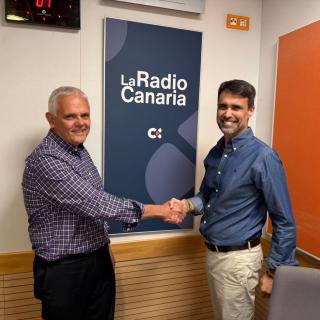Geminids’Maximum activity is expected during the morning of December 14th (00:05 UT). Are you ready? Geminids are, along with Perseids, one of the two great meteor showers of the year. This shower is reliable, punctual and full of stars. Last year's activity reached 200 meteors per hour (ZHR, zenith hourly rates, see Geminids 2015).
Where to look? They seem to come out from Castor and Pollux - their radiant -, the brightest stars of Gemini constellation. With the naked eye and without anything but a lot of patience, you will be able to observe bright meteors. Just as one condition, the sky must be clear and free of artificial light and clouds. Stare at an area of the sky and keep looking at it for a few minutes. We recommend you lie on the floor, wrapped up in warm clothing. The sky will do the rest.
We will broadcast live from the Canary Islands, the entrance of these small fragments left by the asteroid (3200) Phaethon, into the terrestrial atmosphere. This tiny celestial body, is considered the Geminids progenitor since 1983, driving some astronomers crazy. A UCLA team led by Dave Jewitt, studied the results of NASA's STEREO space-based observatories. These are our eyes on the Sun for asteroids and comets hunting for when they approach the star. Jewitt and his team realized in 2010 that Phaethon’s intensity had increased. They thought, then, that the asteroid wasn’t like regular ones, but was something new that they called "rocky comet", a hybrid between an asteroid and a comet. Phaethon is a curious asteroid that gets so close to the Sun that the heat emitted by our star burns the dust residues that cover the rocky surface, which detach and make a gravel tail. And it does this quite often: every 1.4 years, like a comet would do. Jewitt, who will take part in our broadcast live on December the 14th, says: "Phaethon is too hot for water ice to survive, rendering unlikely the possibility that dust is ejected through gas-drag from sublimated ice. Instead, we suggest that Phaethon is essentially a rock comet, in which the small perihelion distance leads both to the production of dust (through thermal fracture and decomposition-cracking of hydrated minerals) and to its ejection into interplanetary space (through radiation pressure sweeping and other effects)".
Javier Licandro, researcher from the Instituto de Astrofísica de Canarias (IAC), qualifies "(3200) Phaethon, with 4 or 5 km in diameter would totally destroy the Earth if it hit us. The collision would produce a global catastrophe that would probably terminate all species including ours. However Phaethon is a minor risk on the list of potentially dangerous bodies. However, we should keep an eye on it because the orbits of these small asteroids pass close to the Earth and are affected by so many effects that may cause a collision in the future".
It is curious that this shower, being one of the most attractive showers for many researchers, wasn’t observed until 1862.
This year, on December 14 at 00:05h UT, the Full Moon will coincide with the moment of Geminids maximum activity affecting the sky’s brightness and obscuring the weakest meteors.
Shooting stars are usually small dust particles of different sizes (some are smaller than grains of sand) detaching from comets or asteroids along their orbits around the sun. The resulting particle current (called meteoroids) is due to the melt produced by the solar heat and they are dispersed along the comet's orbit, which is crossed every year by the Earth in its orbit around the sun. During this encounter, the dust particles disintegrate when entering the Earth's atmosphere very quickly, creating luminous streaks known as meteors.
Transmissions
The STARS4ALL European project, in collaboration with the portal sky-live.tv, will broadcast the meteor shower live from Canarian observatories. The total time of the broadcast will be 30 minutes, separated into three events:
Transmission 1 - Sunset,14 December 18: 30-18: 35 UT-local (19: 30-19: 35 CEST)
Transmission 2 - Departure Moon,14 December 19: 10-19: 15 UT-local (20: 10-20: 15 CEST)
Transmission 3 - Geminids,14 December 22: 00-22: 10 UT-local (23: 00-23: 10 CEST)
Make a wish!
From sky-live.tv we propose, to make a wish for every one of the meteors that cross the Earth's atmosphere. We are in need of good intentions now, more than ever,
Please send us your wish as video or tweet using the hashtag #UnaEstrellaUnDeseo #WishonaStar to @sky_live_tv
Educational Activities
The Geminids observation will be used to develop several educational activities by secondary students (more information in astroaula.net). One of them will be to estimate the meteor shower activity from visual observations.
Three Spanish supercomputing centers, the Centro Extremeño de Tecnologías Avanzadas (CETA-CIEMAT), the Consorci de Serveis Universitaris de Catalunya (CSUC) and Instituto de Astrofísica de Canarias (IAC) will collaborate on the promotion of sky-live.tv website transmissions..
STARS4ALL (stars4all.eu) is a project funded by the European Union's H2020 Program, under contract number 688135. STARS4ALL involves eight institutions (UPM, CEFRIEL, SOTON, ECN, ESCP Europe, IAC, IGB and UCM) from European countries. The goal of STARS4ALL is to raise public awareness of the existence of light pollution in many of the places we live in and the importance of taking measures to reduce it.
Teide Cable Car and SECAT (Study and knowledge of astronomy of Tenerife society) participate in the observation and retransmission of the Geminids from the top of Teide volcano (Tenerife). The Astronomical Association of Fuerteventura (AAF) and Cielos - La Palma participate in the observation from Fuerteventura and La Palma, respectively.
More info
Annual showers 2016
http://www.imo.net/calendar/2016
Audiovisual material
- Geminids high resolution images:
https://www.flickr.com/search/?user_id=65131760%40N06&sort=date-taken-desc&text=Geminids&view_all=1 - Meteor shower videos:
https://www.youtube.com/playlist?list=PL6oc5e7lSjeJrCw26369dYUS-VExFHD40 - Geminids 2015:
https://youtu.be/WxzFcuyml28?list=PL6oc5e7lSjeJrCw26369dYUS-VExFHD40
Contact
Miquel Serra-Ricart, IAC investigator, mserra [at] iac.es (mserra[at]iac[dot]es)
Spain: 0034 649 848 305



